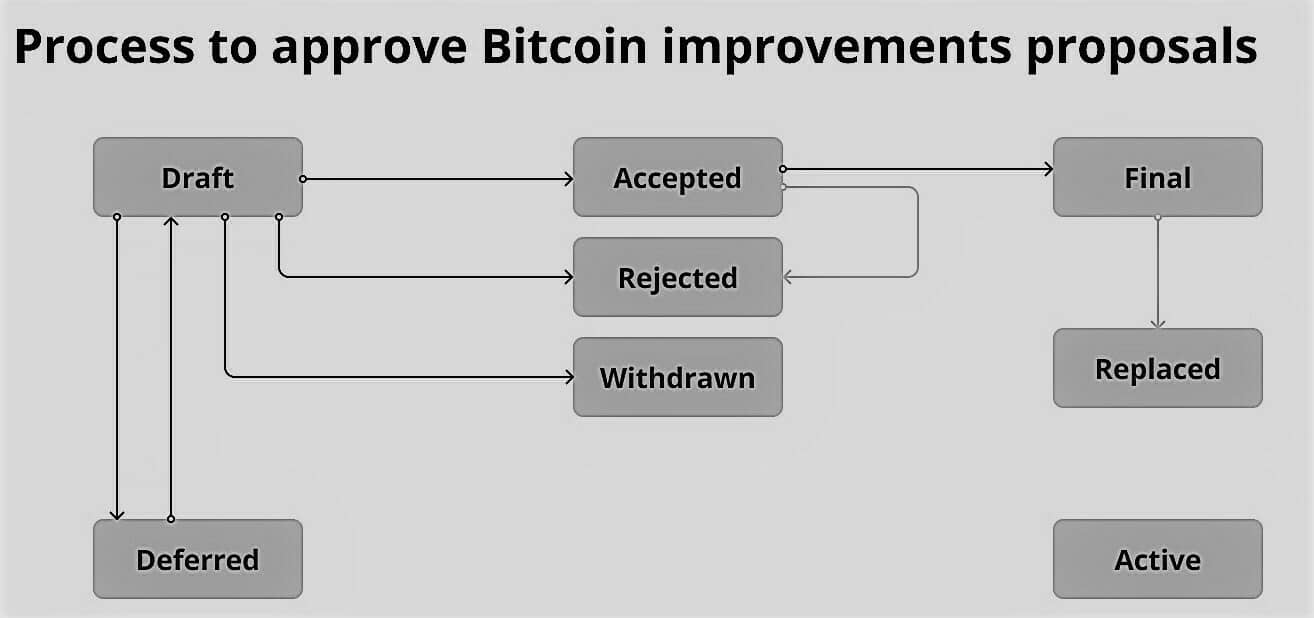What methods are used to improve Bitcoin?
Bitcoin framework is formed of software, hardware, and energy resources, and its governance is entirely controlled by its code.
Everyone appears to agree on the code guidelines by running a node.
Bitcoin has no centralized authority to decide on future core protocol modifications because it is an open-source, decentralized cryptocurrency based on a proof-of-work (PoW) consensus algorithm.
As a result, its development is dependent on community decisions made through improvement proposals known as Bitcoin improvements proposals (BIPs).
Bitcoin’s development process is purposefully long and intentional, from the initial proposal to the final stage, in order to safeguard the network’s security and ensure that confidence in the system is protected at all times.
Even though, not each change to Bitcoin (BTC) demands a Bitcoin Improvement System (BIP), which is particularly intended to improve the protocol.
As in the case of the user interface, for example, there is no need to go through the lengthy BIP procedure.
BIPs will be implemented in anticipation of important protocol upgrades or system-wide changes, such as new types of transactions like SegWit or transaction attributes like replace-by-fee (RBF).
What is a Bitcoin proposal for improvement?
Bitcoin, being a blockchain, requires continuous upgrades, ranging from bug fixes to algorithm changes to code simplification for increased efficiency.
A Bitcoin Improvement Proposal (BIP) is a formal document that introduces new features or processes to the Bitcoin protocol. It is the standard method for promoting ideas, updates, and improvements to the Bitcoin protocol.
BIPs have the power to alter the protocol’s consensus rules, community standards, and development processes.
A Bitcoin Improvement Proposal (BIP) intends to offer upgrade and development coordination within the Bitcoin community, which currently lacks leaders.
Amir Taaki, a British-Iranian programmer, presented the first-ever BIP (BIP 0001) in 2011 to explain what a BIP is, two years after Bitcoin was launched.
Changes to the protocol, on the other hand, aren’t only the responsibility of programmers and developers.
Bitcoin, as an open network, permits anyone and everyone who wishes to participate and has the necessary expertise to submit a BIP.
Now let us take a glance at the process of submitting Bitcoin enhancement proposals.
What is the process of creating Bitcoin improvement proposals (BIPs)?
BIPs are the outcome of spontaneous suggestions and ideas created during meetups, forum conversations, and social media engagement, particularly on CryptoTwitter.
If a proposal has already been presented or perhaps the idea is not in line with the general development standards, preempting an idea in forums and chat rooms before converting it into a BIP can save time for both the ideator and the community.
Every BIP should be filed with the goal of being accepted, and because the process is time-consuming and expensive, BIP authors must exercise extreme caution when submitting a proposal. The chances of a proposal being rejected are much lowered when the community is consulted beforehand.
Anyone in the community could become a BIP champion, which is classified as an author who publishes the proposal in BIP style and structure, promotes it, and discusses it in the appropriate channels to obtain the necessary feedback.
A Bitcoin Improvement Proposal (BIP) should address a substantial change or addition to the Bitcoin protocol.
Little adjustments, bugs, or patches do not have to be turned into BIPs; instead, they can simply follow the usual project development workflow.
Who has the authority to propose Bitcoin changes?
Bitcoin is an open and decentralized network which is not owned by anyone, just like the internet and other technologies.
The Bitcoin community is made up of supporters of technology from all walks of life.
Bitcoin is controlled by developers, miners, and, most importantly, regular users, rather than a single central authority.
Developers and miners certainly drive and improve the network, but users get to choose which software version to use.
Hence, anybody can propose a change to Bitcoin if they have the required skills and knowledge to recommend something relevant to add to the Bitcoin protocol.
Bitcoin improvement proposals (BIPs) – How do they work?
The proposal is shared via email or other communication channels such as Slack before becoming an official BIP, where the community provides initial feedback.
The proposal is shared via email or other communication channels such as Slack before becoming an official BIP, where the community provides initial feedback.
The author can proceed on to the next level and transform the proposal into a BIP if it receives enough support. The proposal should be prepared in the BIP style and format, with a clear technical definition and justification for the feature.
The BIP promoter is in charge of publicising the idea and gaining support for it by responding to feedback and inquiries.
What is the process of approving BIPs?
The first stage in the process is to build a strong community consensus. Even the most beneficial proposals might sometimes take years to be approved or rejected due to a lack of agreement in the community.
When a BIP is sent as a draught to the BIP GitHub, it is evaluated and worked on in a transparent manner, allowing everyone to see its progress and testing results.
And since the Bitcoin blockchain is based on code, protocol modifications must be reflected in the code, and miners must add a reference to their hashed block to indicate whether they accept or reject the change.
Because of the severe implications that certain changes may have for miners, a change in the code must be approved by a large majority of roughly 95 percent unless a compelling explanation for a lower threshold is shown.
The remaining 2,016 miners will have to declare 95% approval (approximately 14 days worth of mining with 10-minute blocks).
We’ll take the latest implementation of the Taproot soft-fork, known as BIP 341, as an example. The Taproot activation was included within Bitcoin Core in April 2021, using a “speedy trial code” to provide a swift resolution to the upgrade.
In the next few weeks, at least 90% of the blocks mined (1,815 out of 2,016 total blocks mined) had an encoded reference signifying that the miners who mined those blocks supported the upgrade.
This prepared the path for the extraordinary consensus that followed in the months after, culminating in the final approval in November 2021.
Users (node operators) choose which Bitcoin Core version to download and run a node that reflects the change, which results in the final and formal approval of a BIP.
After then, all updated nodes will be able to recognize and accept transactions that use the upgraded protocol.
The following are the key steps in the approval process:
- Anybody can propose a Bitcoin Improvement Proposal (BIP) to alter the Bitcoin core;
- The BIP must be passed by an editor.
- There must be a majority vote of at least 95% among miners for the BIP to be approved; and
- new software must be adopted by the community.
Here is a graphic of how BIP approval works:

What kinds of Bitcoin improvement proposals (BIPs) are there?
There are three types of Bitcoin improvement proposals :
- Standard
- Informative
- Consensus BIPs
Standard BIPs
They seek to improve the protocol by identifying standards used by Bitcoin applications such as wallets and exchanges. As a result, they require consensus to be accepted.
For illustration, they might offer encoding methods for safeguarding Bitcoin, or they might suggest interoperability, which means that wallets should be able to identify and function with any Bitcoin address in order to be functional.
Informational BIPs
They just serve as a source of information. They provide the community with broad guidance but do not add a new feature, hence they are not required to gain community consensus.
Consensus BIPs
Consensus BIPs, also known as process BIPs, aim to change a process and, like standard BIPs, necessitate universal consensus despite incorporating changes that are not part of the Bitcoin protocol. Consensus changes must be activated explicitly on the Bitcoin network.
BIPs are an important part of Bitcoin governance and an outlay approach to improve and upgrade the world’s most popular cryptocurrency with no central authority. In the end, this is what determines the technology’s success.













Discussion about this post